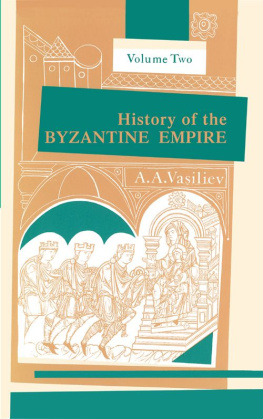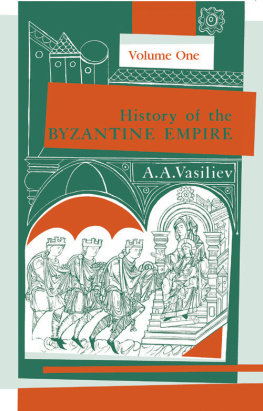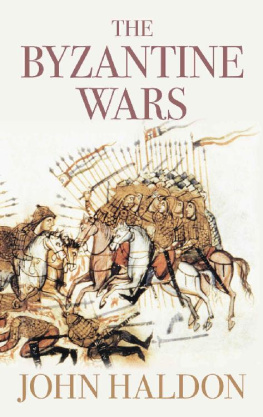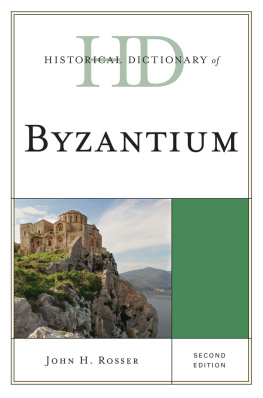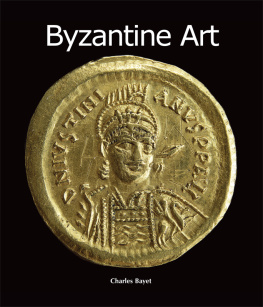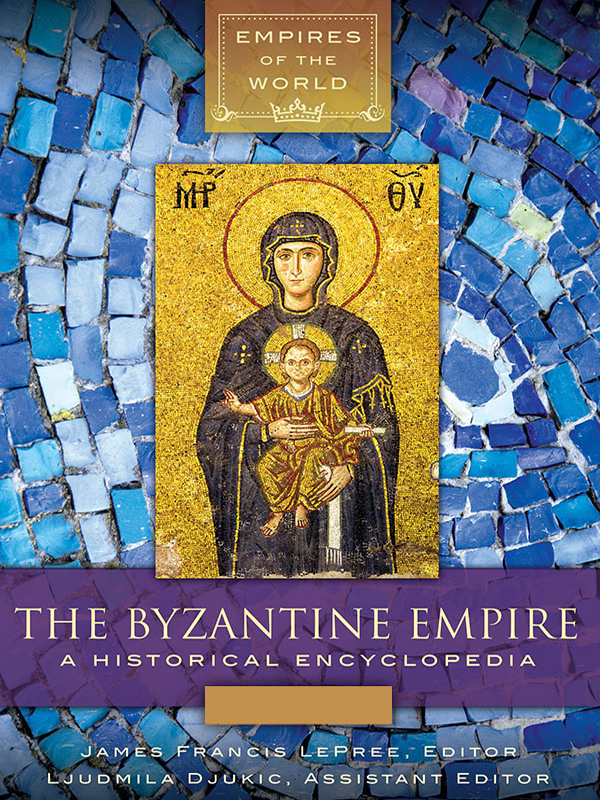The Byzantine Empire
Recent Titles in
Empires of the World
The Persian Empire: A Historical Encyclopedia
Mehrdad Kia
The Spanish Empire: A Historical Encyclopedia
H. Micheal Tarver, editor, Emily Slape, assistant editor
The Mongol Empire: A Historical Encyclopedia
Timothy May, editor
The Ottoman Empire: A Historical Encyclopedia
Mehrdad Kia
The Roman Empire: A Historical Encyclopedia
James W. Ermatinger
The British Empire: A Historical Encyclopedia
Mark Doyle, editor
The Holy Roman Empire: A Historical Encyclopedia
Brian A. Pavlac and Elizabeth S. Lott
Copyright 2019 by ABC-CLIO, LLC
All rights reserved. No part of this publication may be reproduced, stored in a retrieval system, or transmitted, in any form or by any means, electronic, mechanical, photocopying, recording, or otherwise, except for the inclusion of brief quotations in a review, without prior permission in writing from the publisher.
Every reasonable effort has been made to trace the owners of copyright materials in this book, but in some instances this has proven impossible. The editors and publishers will be glad to receive information leading to more complete acknowledgments in subsequent printings of the book and in the meantime extend their apologies for any omissions.
Library of Congress Cataloging-in-Publication Data
Names: LePree, James Francis, editor. | Djukic, Ljudmila, editor.
Title: The Byzantine Empire : a historical encyclopedia / James Francis LePree, editor ; Ljudmila Djukic, assistant editor.
Description: Santa Barbara : ABC-CLIO, [2019] | Series: Empires of the world | Includes bibliographical references and index.
Identifiers: LCCN 2019008314 (print) | LCCN 2019012095 (ebook) | ISBN 9781440851476 (ebk.) | ISBN 9781440851469 (set : alk. paper) | ISBN 9781440851483 (v.1) | ISBN 9781440851490 (v.2)
Subjects: LCSH: Byzantine EmpireEncyclopedias.
Classification: LCC DF504.5 (ebook) | LCC DF504.5 .B98 2019 (print) | DDC 949.5/0203dc23
LC record available at https://lccn.loc.gov/2019008314
ISBN: 978-1-4408-5146-9 (set)
978-1-4408-5148-3 (vol. 1)
978-1-4408-5149-0 (vol. 2)
978-1-4408-5147-6 (ebook)
23 22 21 20 19 1 2 3 4 5
This book is also available as an eBook.
ABC-CLIO
An Imprint of ABC-CLIO, LLC
ABC-CLIO, LLC
147 Castilian Drive
Santa Barbara, California 93117
www.abc-clio.com
This book is printed on acid-free paper 
Manufactured in the United States of America
CONTENTS
The Byzantine Empire: A Historical Encyclopedia is a remarkable resource for high school and undergraduate students as well as for general readers interested in the Byzantine Empire. The encyclopedia provides the means for readers to investigate the history and culture of the empire that served as a symbol of Christian culture for over 1,000 years. The encyclopedias two volumes contain almost 220 entries written by expert contributors and organized into the following eight topical sections:
Government and Politics
Organization and Administration
Individuals
Groups and Organizations
Key Events
Military
Objects and Artifacts
Key Places
Each section begins with an overview essay followed by a wide array of entries designed specifically for a diversity of reader interests. The topic entries are alphabetized within each specific section. Each entry contains See also cross-references to related entries in that and other sections and concludes with a current bibliography of important related information resources, both print and electronic. The encyclopedia also provides a table of contents permitting easy access to areas of specific interest, a general introduction introducing readers to the general context of Byzantine history, and a chronology of important events. Brief sidebars complement many entries, providing useful and relevant information. Following the thematic sections are numerous primary document selections that will be useful for students in preparing projects and presentations and for general readers in becoming acquainted with important sources and with important events and personages of Byzantine history. The encyclopedia also includes a select bibliography of useful primary and secondary sources that provide readers with access to the best past and present Byzantine scholarship. Finally, The Byzantine Empire includes a glossary of important terms in Byzantine history that are used in the entries and that may be unfamiliar to student and nonspecialist readers, as well as a general subject index that provides more in-depth access to names and terms mentioned in the text of the entries.
I dedicate this book to my wife, Myrna, for her constant encouragement and support. I would also like to acknowledge Ljudmila Djukic for her many fine contributions to this publication and honor the memory of Professor Thomas Head, my dissertation supervisor, for his patience and the knowledge he gave me, which I shall never forget. Finally, I would like to especially mention Matthew T. Herbst and Brenda K. Thacker for the special contributions they made above and beyond the call of duty to bring this publication to a successful conclusion.
FROM ROMAN TO BYZANTINE
Byzantine history is a continuation of Roman history. The empire that we refer to as Byzantine today was called Roman by those who ruled and inhabited it. Roman political, social, and cultural institutions remained at work in the Byzantine Empire down to its fall in the 15th century. In the 17th century, scholars in the West began to refer to the period of Roman history after Constantine as something different, designating this Byzantine, a reference to Byzantion (Latin, Byzantium), which was the classical predecessor of Constantinople and often a synonym for it. This terminology was influenced by a well-established Western anti-Byzantine bias, whose roots were in the medieval period, which viewed the West as superior. This terminology was useful in the attempt of these scholars to distance Byzantium from this Western heritage.
Fortunately, historical study today has moved beyond medieval and early modern biases to recognize connections and continuities, something already apparent to astute observers in the past. The great 18th-century British historian Edward Gibbon, in his classic study, The Decline and Fall of the Roman Empire, told the story of the Roman Empire from its high point in the second century CE down to the fall of Constantinople in 1453. He well understood that this was all Roman history. Yet, the terms Byzantine and Byzantium have since generally been adopted by modern historians to denote the Christian empire that existed from the 4th to the 15th centuries CE in contrast to the pagan Roman Empire that preceded it. Still, it must be noted that the inhabitants of the Byzantine Empire always called themselves Rhomaioi, the Greek word for Romans, and even the Ottoman Turks called their Orthodox Christian subjects by the name that they called themselves, Rum (or Roman), until the early 20th century. Byzantine emperors understood themselves to be Roman emperors and heirs of the imperial tradition of Augustus.
And so, modern scholars have generally adopted the term Byzantine to designate the empires long history from the 4th through the 15th centuries CE. Scholars refer to the empires early period from the fourth through sixth centuries CE both as the early Byzantine period and also as the late Roman Empire interchangeably, making this age a notable transitional period, where the foundations of the Byzantine civilization were established.

![James Francis LePree Ph.D. (editor) The Byzantine Empire [2 volumes]: A Historical Encyclopedia](/uploads/posts/book/296844/thumbs/james-francis-lepree-ph-d-editor-the-byzantine.jpg)



